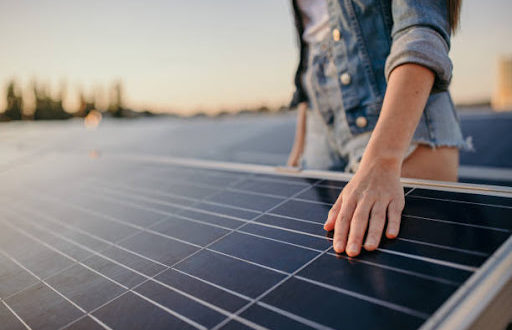Solar panels are the most crucial component of a solar power system. You use them to collect solar energy and convert it to electrical energy.
Solar panels come in a variety of designs and sizes. Most of them are available in 60, 72, or 90-cell configurations. Solar photovoltaic cells (PV cells) harness energy from the sun. Each cell comprises three parts: boron, silicon, and phosphorus. Silicon is the semiconductor; boron has a positive charge, and the phosphorus layer has a negative charge.
Solar panels produce energy in direct current (DC) form. But, home and industry appliances work using alternating current (AC). So, what happens is that the DC is directed to a solar inverter, which converts it to AC. This conversion of light energy from the sun into electricity is commonly known as the ‘photovoltaic effect.’
Types Of Solar Panels
There are several types and configurations of solar panels to choose from. However, the ideal one for you will be determined by your needs or the purpose for which you intend to use them. As a result, you must ensure that you choose the right one depending on your requirements.
- Thin Film Solar Cells (TFSCs)
Various materials, including copper, cadmium, and silicone, are used to make these panels. They’re created using thin film deposition systems such as the HEX series from Korvus Technology. Furthermore, these solar cells are extremely thin and usually don’t come in fixed sizes. Also, they don’t need a frame backing, unlike monocrystalline or polycrystalline solar panels.
Pros
- They’re easy to manufacture and cost-effective because only a few materials are required.
- They’re flexible, so you can use them in various applications.
- They maintain average efficiency levels at high or low temperatures.
Cons
- They have the lowest operating efficiency rating out of all the three types of solar panels (about nine percent).
- More space is required to fit these solar panels because of lower efficiency.
- They’re less durable than other solar panels and have shorter warranty periods.
Because of their low efficiency, TFSCs may not be an ideal option for you if you have limited roof space.
- Silicon
Solar cells made of silicon are, by far, the most prevalent. Furthermore, they’re among the most efficient. These cells are constructed of silicon derived from sand grains. Monocrystalline and polycrystalline solar cells are the most common silicon-based cells.
- Monocrystalline Cells
They’re also called single-crystal panels because they’re composed of one pure silicon crystal, then cut into several other wafers.
Pros
- They’re more aesthetically pleasing than other solar panels because of their deep black color.
- Because electrons in single crystal panels have more liberty to move, monocrystalline cells provide a high-efficiency rating. This leads to better space efficiency because you won’t need as many panels to generate solar energy. Their maximum efficiency is estimated to be around 20%.
- They generally last longer because of their high-quality materials. With these panels, you can expect to see warranties spanning up to 25 years.
Cons
- They tend to be the most expensive of all options because they use high-quality materials.
- Monocrystalline cells tend to slump in efficiency when temperatures get extremely high.
- The process of making these cells results in much wastage.
Consider buying monocrystalline cells if you want to build an efficient solar power system, but note that they can be quite expensive.
- Polycrystalline Cells
The term ‘poly’ implies that these panels are created from more than one silicon crystal. Fragments of silicon are melted and then bound together to form these polycrystalline solar cells.
Pros
- They’re more affordable compared to monocrystalline cells.
- There’s little wastage that goes into the process of making these panels.
Cons
- These cells take up more space because they’re less efficient than monocrystalline types. Their efficiency is estimated to be approximately 14%, lower than that of monocrystalline panels.
- They’re less efficient in high-temperature conditions.
If you have a small budget, these are your second-best option. These panels may be slightly less efficient but are much more affordable.
- Organic Solar Cells
Organic solar cell technology is still in its infancy. However, several functioning concepts have already been developed. Such panels are made of carbon-based organic compounds like polymers. It’s unclear when they’ll become mainstream. However, if they do, they may prove to be a viable alternative to existing solar panel technology.
Pros
- Organic solar panels require much less energy to produce.
- No exhaustible elements are used to produce them, unlike thin-film and silicon-based panels.
Cons
- The technology is underdeveloped and unpredictable at the moment.
- It’s still quite inefficient. More research is required to make it viable.
Organic solar cells are a fascinating technology to keep an eye on in the future. It could be a hit once scientists are able to make it efficient and affordable.
Conclusion
Each solar panel type has pros and cons, as deduced from the preceding discussions, so you must select an option that meets your specific needs. For example, silicon-based panels are the way to go if your top priority is high efficiency. In contrast, thin-film ones are better suited for buildings with unique structural designs since they’re more flexible. In any event, it’s always a good idea to consult an expert before settling on a certain type of solar panel.



